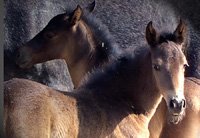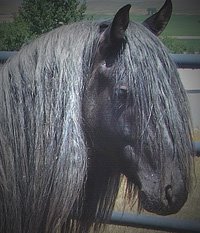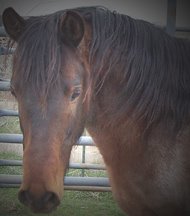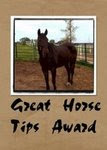 Thanks to all who have submitted their nominations for The Best of the Barb Wire Contest. One week remains in which to enter in the drawing for a free, custom Indian bosal (modeled at left by the lovely Acey) from Crazy Ropes. Click here to find out how!
Thanks to all who have submitted their nominations for The Best of the Barb Wire Contest. One week remains in which to enter in the drawing for a free, custom Indian bosal (modeled at left by the lovely Acey) from Crazy Ropes. Click here to find out how!_______________
Typing all these reminders about the contest has gotten me thinking. Why do I ride bitless?
In answering the question, I started a post that soon sounded like every other anti-bitting manifesto under the sun. In that draft, I talked about how bits operate on the pain principle:
Bits operate on a pain principle, that is, the horse does as he's told in order to avoid pain in his mouth. Many bits are willfully designed to operate in precisely this fashion, and even so-called "mild" bits will cause pain in the hands of an unskilled, insensitive, or careless rider.
I talked about how training and safety:
Many people operate under the assumption that, in most cases, a bit is necessary to ensure rider safety. "Why on earth don't you use a bit?" they ask me, agog.
My favorite reply: "Why on earth do you use one?"
The answer usually includes a reference to the hardness of the ground (often in combination with the rider's inability to bounce), or else the danger of a bolting horse. "Of course I'd like to ride without a bit," they say, "but I just can't risk it."
I beg to differ. You don't need a bit to control your horse from the ground, do you? No? Then why should you need one to control your horse from the saddle?
No really, why?
It seems to me that a horse that runs through a bitless bridle doesn't have a tack problem -- he has a training problem. Many people agree with me as far as that goes. "But what if he spooks?" they say. "I have to be able to stop him."
When it comes down to it, though, a truly panicked horse isn't going to stop, no matter what you've put on his face. Bolting horses run blindly into traffic, through barbed wire fences, off cliffs. They run until they feel safe.
Guess what's not going to make a horse feel safe: Pain. Guess what tight reins against a bit cause: Pain. A bit isn't going to stop a bolt, and it might make things worse.
I talked about the value of other aids:
Although most people assume we "steer" a horse by directing his head, not unlike a front wheel drive vehicle, this assumption represents a fundamental misunderstanding of equine physiology. Horses are not built to pull themselves around. Their engines are in their hindquarters, and it is from there that everything from starting to stopping to collection to turning originates.
My riding improved dramatically when I made this connection. I began talking to my horse's hindquarters instead of his head, guiding him with seat and leg, using reins not to point him in the right direction, but simply to block him from moving in the wrong direction. The result was improved impulsion and responsiveness, and almost complete release of my horse's head. These days, except when practicing single-rein-stops, I use the reins only minimally.
I considered the issue of compliance vs. force:
The bitless philosophy is related to natural horsemanship. It assumes that if we build partnerships with our horses and establish ourselves as trustworthy leaders in these partnerships, then our horses will choose to obey.
The power of “yes” is in the possibility of “no.”
I disagree with those who contend that all horses suffer mental and/or physical anguish when bitted. I have seen too many horses reach eagerly for their bits and mouth them contentedly to believe that bits are inherently cruel.
I believe all the above, but the truest answer to the question of why I ride bitless is also the simplest. It was in the draft. Did you catch it? I didn't either, at first. I had to think for a while before I realized that the reason I don't use a bit is simply that I don't need one.
Even on Aaruba’s fractious days, when he teeters on the edge of explosiveness; even when Consolation and I struggle for dominance; even astride Acey who is so green we haven’t trotted yet; even during the various shies and bolts that come with hours on the trail, I have never wished for a bit. I simply don't need one.
 Aaruba got me started on the concept. Having ridden with bits my entire life, I’d planned to start him in a full-cheek snaffle, then switch to a copper D-ring and stay there. I soon discovered, however, that the trainer who started Aaruba had not only forced a saddle on him by locking him in a cattle squeeze, but had hurried the bitting process so that Aaruba was terrified of the thing.
Aaruba got me started on the concept. Having ridden with bits my entire life, I’d planned to start him in a full-cheek snaffle, then switch to a copper D-ring and stay there. I soon discovered, however, that the trainer who started Aaruba had not only forced a saddle on him by locking him in a cattle squeeze, but had hurried the bitting process so that Aaruba was terrified of the thing.
Despite being annoyed by his infomercial of a website, I ordered Dr. Cook’s Bitless Bridle. It took a few weeks for Aaruba to relax about being bridled, but finally he began to trust that nothing was going in his mouth. I experienced no difference in his responsiveness under saddle, certainly no loss of control. If anything, Aaruba listened better because he was more at ease.
When we began endurance conditioning last spring, I discovered the benefits package that comes with bitless riding. I needed only one piece of headgear for an entire session, from catching to cooling out. My horse could eat on the trail (Dr. Cook’s Bitless Bridle wasn’t good for this due to its tight noseband, but I have since switched to a Crazy Ropes Indian bosal and won’t go back). I never needed to lead my horse by the reins. I never bruised my horse's mouth when he tripped and yanked the rein.
Looking back over the hundreds of miles I've ridden this year, I can’t think of an experience for which I would rather have had a bit in my horse’s mouth.
Why not?
_________________________________________________
Related Posts
Call Me Crazy: A Word about Natural Horsemanship
Twenty Minutes in Photos: Trust-Based Training at Work
Heart in My Hands: Gentling the Unhandled Horse
_________________________________________________________
Want to read more posts like this one? We deliver!
Subscribe to The Barb Wire









4 comments:
Nice informative post, I enjoyed reading it. I would love to try going bitless.
Although I haven't got around to riding without a bit, I find myself rarely using it, although one of our barb mares is easier to steer than the other one. With Arwen, you only need to "think" where you want to go and how you want her to turn and she'll do that spontaneously. Sahara is a different chapter, but she's the most dominant horse I've ever met and it's hard getting her to concentrate on the rider as long as there are other horses involved.
My new 'favorite post'! ;)
And to go one step further is to ride with no headgear at all...
http://akalranch.com/lily/images/060415-9922web.jpg
Lily will listen for about 20 minutes before she decides that she is going to make the decisions. We have also not ventured outside the arena yet. I think that grass would be just too tempting!
great post on bitless! i'm a fan too and have posted on when and why i chose to go bitless. my philosophy is a little different, and i use bits as well, but i think our basic premise is the same. and i couldn't agree more that the last thing you want when riding a distressed horse is a bit! they definitely DO NOT give more control, but generally make the situation worse! anyway, interesting blog. i'll be back!
Post a Comment